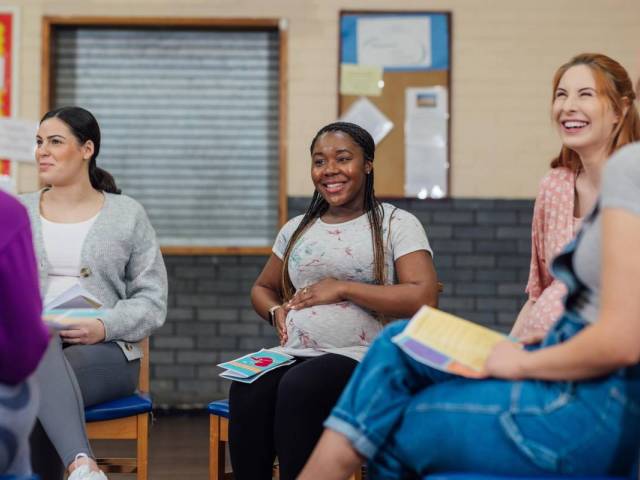While there are certainly many bright spots to celebrate, our public school system is struggling. At both the school and district levels, there are unprecedented levels of divisiveness, overwhelm, and fatigue for both families and educators. Politics and culture wars have increasingly entered the classroom and, with them, a cloud of mistrust has descended on the U.S. school system.
As I have witnessed over the course of almost a quarter of a century in public education, our schools are not revamping their approaches to engaging with families fast enough to meet the shifting demographics. They are also falling back on conventional family involvement approaches that are event-focused rather than centered around fostering more frequent two-way communication and building authentic, ongoing relationships between educators and families. As the researcher Michael Fullan writes, “Nowhere is the two-way street of learning more in disrepair and in need of social reconstruction than in the relationship among parents, communities, and their school.”
Additionally, reforms that are aimed at creating “better schools,” especially for low-income and students of color, continue to fail because educators avoid addressing one of the larger barriers to progress—investing small amounts of time in the best practices that build greater trust with underrepresented families, such as relationship-centered home visits, apps like TalkingPoints that spark two-way communication and transcend language barriers, or a quick phone call or text to share positive news with families about their child’s progress. Consequently, the absence of strong school-family partnerships can exacerbate inequities.
X

Is there an alternative? The Families and Educators Together (FET) team framework is one model of how to steadily transform school communities. Over the course of the last eight years, I have had the pleasure of coaching and co-facilitating with parent and educator team leaders at 30 schools with FET teams. Based on my learnings from hundreds of these monthly team gatherings, I identified eight key pathways to foster meaningful collaboration and strengthen relationships between educators and diverse families.
As I explore in my book, On The Same Team: Bringing Educators and Underrepresented Families Together, authentic school-family partnerships prioritize listening to families, honoring them as experts, and collaborating with them as equal partners. Here are eight ways to make that happen in spaces where educators and families come together.
1. Be clear about intentions
An effective facilitator has tremendous clarity about their intentions and conveys them transparently. As my facilitation mentor Diane Musho Hamilton once said to me, “Intention drives attention.”
That means that our intention drives our attention to what we privilege. “We often choose the template—and the activities and structure that go along with it—before we’re clear on our purpose,” writes Priya Parker in The Art of Gathering. “Make purpose your bouncer. Let it decide what goes into your gathering and what stays out.”
Great facilitators balance openness and attunement to the group’s need with intentionality.
2. Listen deeply
All people want to feel heard. Great leaders continue to develop their capacity to listen deeply. Deep listening builds a sense of sameness, calms the nervous system, and can be transformative, as we drop the “I” reference point and try to see things through a new perspective. Deep listening is distinct from our typical approach to listening in that we are:
- Giving our full attention by avoiding multitasking or thinking about our response
- Reading cues from people’s body language, in recognition of the fact that 93% of communication is non-verbal
- Facing the speaker, making steady eye contact, and showing an awareness of our own body language
- Tuning in to what people are both saying and not saying in their comments to gain insight and spark new inquiries
- Using reflective listening techniques such as summarizing, synthesizing, or acknowledging an impactful phrase or sentence when the speaker finishes sharing
- Listening with an open heart and a willingness to be transformed
Author and educator Parker Palmer reminds us that “as our listening becomes more open—and speakers start to trust that they are being heard by people whose only desire is to make it safe for everyone to tell the truth—their speaking becomes more open as well.”
3. Ask great questions
Ask great questions. It sounds simple enough, but if we’re honest, most of us are more focused on sounding smart in our answers or comments. Questions can be like “lanterns,” illuminating new possibilities for partnership and collaboration. In my experience, the quality of FET gatherings is often shaped by the quality of our questions. Thoughtful and thought-provoking questions reveal our openness to other perspectives, show that we truly value others, and communicate respect and interest.
Since great questions emerge from sincere curiosity, as you listen deeply, try to pay attention to what intrigues you or sparks wonder. Ask follow-up questions that energize the group, lead participants to share in greater depth, or take the conversation deeper. The best questions tend to:
- be open-ended;
- be grounded in a genuine desire to learn;
- be provocative by interrupting the person’s thinking and causing disequilibrium;
- come from a mindset of not already knowing the right answer;
- expand rather than restrict the arena of exploration; and
- evoke passion.
4. Know your role
To be effective, all team leaders need to be clear on what their role is as facilitator. This definition can be fluid depending on the needs of the group, the context, and the desired outcomes. I like the definition Parker provides in The Art of Gathering—that a facilitator “is someone trained in the skill of shaping group dynamics and collective conversations.”
How do we bring forth others’ full range of humanity? Accomplishing this is particularly important in spaces like FET, where our aim is to create transformation and challenge the status quo. We do so by making the space safe for the soul to emerge, which is perhaps the greatest challenge any facilitator faces.
It is also crucial as facilitators of diverse spaces to be attuned to how the powerful and privileged are affecting the conversation and how the marginalized are being impacted. In FET, we consistently use structures that make space for marginalized voices, such as timed dyads or sharing circles that give all participants a chance to share their perspective.
5. Take a relational approach

This essay is adapted from On The Same Team: Bringing Educators and Underrepresented Families Together (Solution Tree Press, 2023, 248 pages).
Facilitators need to be cautious of reducing meetings to a transactional approach, particularly in settings that have historically marginalized certain voices and are striving to change existing paradigms. One of the main reasons we struggle to make progress in creating more equitable systems is due to a lack of relationships. For relationships to flourish, it is crucial that facilitators are intentional about devising structures that foster psychological safety for each individual and foster group unity.
In the early years of FET, I learned that if we jumped straight into group conversation, both families and staff were often reluctant to share. This is the reason FET meetings begin with mealtimes, team builders, and opening circles. This approach honors the wisdom of the adage Go slow to go fast. To accomplish this, facilitators need to ensure that strengthening relationships is the priority. In a meeting, this translates to focusing as much on building connections and relating to each other as on discussing topics. People come first, before the process and the goals.
6. Serve as a connector
It is important that team leaders are skilled not just at building relationships with participants but also cultivating relationships between them. While the facilitator needs to hold the whole—prioritizing what will benefit the group more than what might serve individual needs—it is also important for the facilitator to pay attention to and connect with the individuals in the group.
The FET leaders who most effectively strengthen rapport or pivot mid-meeting track the body language and facial expressions of individual participants. They also fortify connections with team members that they don’t know well by holding conversations before and after gatherings with them. This ultimately strengthens the whole team.
Team leaders also need to see themselves as bridges that are helping individuals connect with each other and not solely with them or the group as a whole. As Priya Parker writes, “One measure of a successful gathering is that it starts off with a higher number of host-guest connections than guest-guest and ends with those tallies reversed, far in the guest-guest favor.”
7. Track individual and group energy
Great facilitators are responsive to the energy in the space and adjust accordingly, as well as work to shift the energy to heighten levels of both individual and collective engagement. I learned from Diane that facilitators need to track and assess the “subtle energy” in the group and not simply attend to the content of what is being said.
It’s like when you are in a car with someone who is angry—you can’t see the anger, but you sure can feel it. Subtle energy is felt but can’t be measured easily. It is not always visible, although sometimes it can be reflected in people’s body language or facial expressions.
8. View “self as instrument”
A crucial step on the path to being a strong facilitator is to become more self-knowledgeable and self-aware. As we help guide a group, we are not just downloading tips and tools; we are bringing our own humanity into greater service and enacting more of who we are to strengthen our communities.
Becoming an effective facilitator means committing to significant and ongoing personal development and viewing “self as instrument,” as Diane called it once, in conversation. Research finds that the more developed a person becomes, the more Self-awareness they have.
The driving notion behind self-as-instrument is that we see ourselves as a powerful force for change. Like a musical instrument, we need to be optimally tuned, which means constantly refining ourselves. This requires taking a closer look at our strengths, weaknesses, and biases.
It’s also vital that team leaders embody a growth mindset. This makes them flexible leaders who are open to improvement and receptive to constructive feedback, be it from families or colleagues. By being humble and approachable, they become the kind of leaders that teams need to do such dynamic cross-cultural work.
When there is trust and collaboration between educators and families, children feel it. They feel accepted and valued. They feel known. Then school and home are like parentheses, with children nested inside a community that feels connected rather than fragmented. In that kind of quality learning environment, it is safer to learn.













